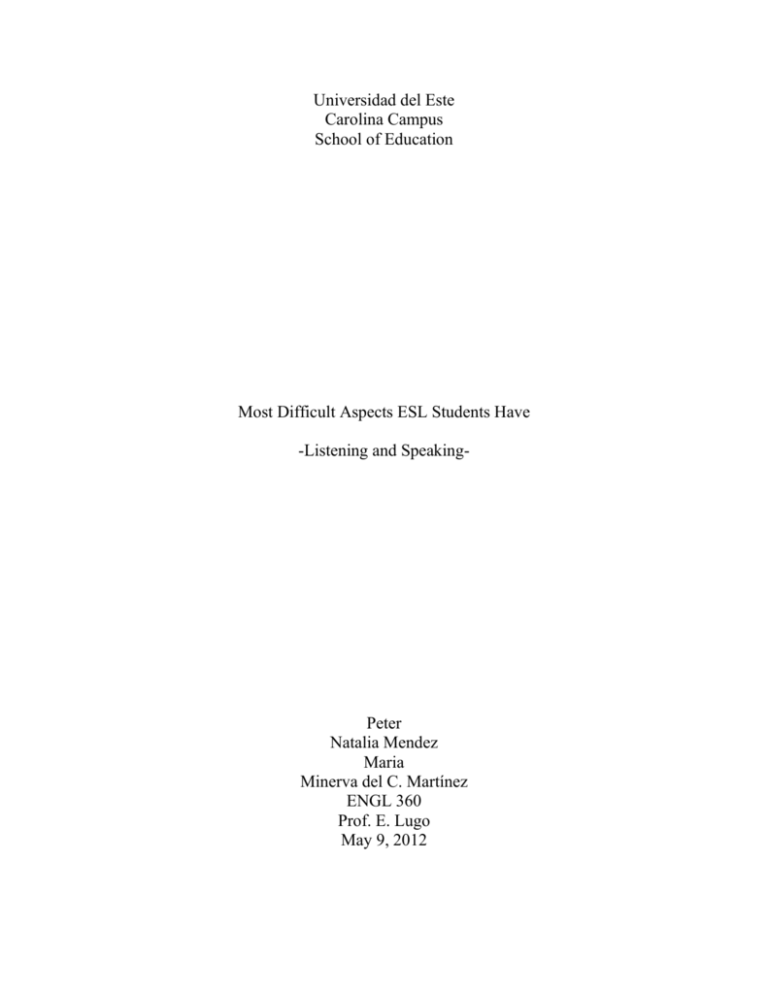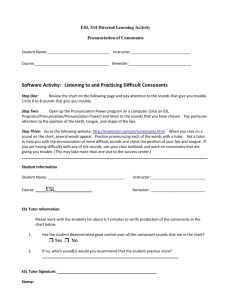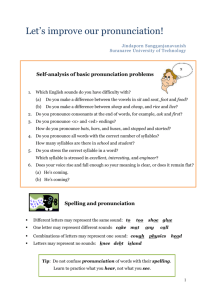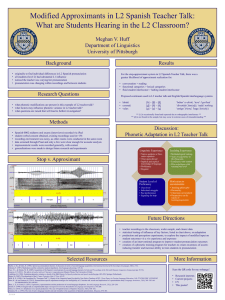Lugo`s final project essay
advertisement

Universidad del Este Carolina Campus School of Education Most Difficult Aspects ESL Students Have -Listening and Speaking- Peter Natalia Mendez Maria Minerva del C. Martínez ENGL 360 Prof. E. Lugo May 9, 2012 Lorenzo’s Case of Speaking. Lorenzo is the new student in Dr. Pedro Albizu Campos in Toa Baja. He comes from a nationalist family. Lorenzo doesn’t ever walk into the classroom late. His written samples are very good. He never speaks English in the classroom. The teacher assigned an oral report on the Spanish-American war. He refused to do it because he didn’t want to speak English. The student will fail if he doesn’t, because he also doesn’t participate in class. Lorenzo shows up with an arrogant attitude. The parents don’t encourage the student to participate either. They even show disrespect for the class. The student and the parents don’t feel like English is a relevant part of their cultural and political values and ideas. How will the teacher cut off this barrier? The parents don’t realize that this attitude has rendered Lorenzo’s speaking and pronunciation in English. The teacher allows Lorenzo to do his oral report on the colonization of Puerto Rico. The teacher noticed that instead of saying ‘them’ he pronounced ‘tem’; also he pronounced ‘shursh’ instead of ‘church’. His attitude towards the English language changed a bit. It was evident that the conflict had rendered his ability to pronounce. How are we going to address this problem? How are we going to help the student without labeling him? Most Difficult Aspects ESL Students Have English verbs tenses—past & past participle: English verbs tenses are one of the most difficult aspects for ESL learners. Many of the English sounds do not have an equivalent is Spanish. Pronunciation is difficult to grasp if the student does not pay attention or does not have enough practice. Pronunciation of simple past and past participle is hard because Spanish do not have verbs with the same ending sounds in English. For example, the endings t, d and ɪd are not present Spanish. When verbs end with those sounds, the student most likely does not make the sound or the sounds are omitted. The most common practice is when students are reading English; they read each sound like if they are reading in Spanish, literally. Teacher needs to have dynamic strategies. They are necessary to break the students’ lack of participation and the habit of not speaking in English in the classroom. Motivation and desire are the key aspects in the process of teaching and learning experience. One strategy students will enjoy is the verbs charade. The teacher prepares three stacks of actions verb, regular and irregular. Three students will take turns in acting out the verbs. One of them acts the verb and the other two try to guess the verb. When the verb is deciphered, students change seats and the game continues. Board games are also a good choice for secondary school students. Board game can be set off on the classroom floor by the teacher or can be prepared as individually board to play in groups. Questions, sentences and situations can be written on cards. When the student stop at specific place, after throwing the darts and found out his/her number to walk, the card can be read, depending on the place (questions, sentence or situation). The student will answer accordingly. Puzzles and game words can also be included as part of the activities for the group. Tests can be organized in the same way to make them more inviting to the students. Another strategy is dramatization. Common day-to-day situations can be created by the students in the classroom. They themselves can act out what they write. This will invite to be more proactive and will give them the opportunity to be realistic. Shyness will wear out little by little and nervousness will also faced out. The sky is the limit for creativity. The Internet is a great resource for watching videos, pictures and news. These current events can be used to start conversations and to create situations of comparison/contrast and debates. Rules of pronunciation for certain English verbs as the text describes those (Hill &Brodford, 2000): “Pronunciation of the regularly formed preterite and past participle forms (those ending in –ed) is as follows: a. If the lexical verb ends ina voiceless consonant sound other than [t], -ed is added with the value of [t]; leap/leaped [lipt], kick/kicked [kikt], pass/passed [pæst], laugh/laughed [læft]. The voiceless consonants that can occur un final position in verbs are [p, t, k, f, ɵ, s, ʃ, tʃ ]. b. If the lexical verb ends in a vowel sound or ina voiced consonant sound other than [d], -ed is added with the value of [d]: sew/sewed [sod], tease/teased [tizd], blame/blamed [blamd], stab/stabbed [stæbd], tag/tagged [tægd]. The voiced consonants that can occur in final position in verbs are [b, g, v. ð, z, Ʒ, d Ʒ, m, n, ŋ, l, r]. c. If the lexical verb ends in either the sound of [t] or [d], then –ed is added with the value of [ɪd] pronounced as an extra syllable: seat/seated [sitɪd], wade/waded [wedɪd].” Trouble with Ch,Sh,V and B : ESL students might find it very difficult to difference the sound between ch and sh. They also might find it difficult to find the difference between V and B. It’s because rarely students are taught the difference in utter of V and B and Ch and Sh in Spanish. They are almost always taught as the same sound. In this case the student cannot at all find the difference between those sounds Sh,Ch,V and B. I have found few tips, and strategies to target the problem without making the student feel uncomfortable or frustrated. Here they are: First Ch and Sh 1. When you say the sh sound don’t let your tongue touch the roof of your mouth. The air should pass freely around your tongue. Round your lips to make this sound. Here are some words with the sh sound: show, washing, cash. 2. When you say the ch sound your tongue touches the roof of your mouth and briefly stops the air. Here are some words with the ch sound : chair, teacher, much. Try to pronounce the following short dialog using the correct sounds of sh & ch. Shopper: How much is the chicken? Clerk: The chicken is on sale. It’s really cheap. Will that be cash or charge? Shopper: I’ll have to charge it. I don’t have any cash. Also try tongue twisters! They are fun! Here are a few: Chops shops stock chops. Shredded Swiss Cheese. Cheating, Sheila cheated surely on Chester’s precious choices. Check the sure shot charged surely by changing shift She shan’t check Charley’s shackles. For the V and B I found it a bit tricky yet I found a nice little strategy, similar to Previous ones. You give the student’s a long list of words with both the sounds in it, beforehand you have to explain the sound to them and how to make it for example. 1. Have your lips pressed together and then slightly push air out of your mouth forcing your lips apart. 2. Help them to notice the difference between the lips placement with B and V. For example when you pronounce B /b/ The lips momentarily press and quickly part into a slight burst of movement. 3. With V /v/ you momentarily sink your upper teeth to your lower lip and quickly part into a semi or more soft burst. A fun game to do with your students is/are: A Shoppers' Nightmare Level: Easy to Medium This is an oral communication activity appropriate for ESL learners . This game is designed for practicing "shopping" dialogues and vocabulary. Materials: Items and play money. Object of Game: To accumulate as many Items as possible. Students are divided into clerks and shoppers. The clerks set up "stands" to allow easy access for all shoppers (e.g. around the outsides of the room with their backs to the wall). The shoppers are given a set amount of money and begin at a stand where there is an open space. Students shop, trying to accumulate as many items as possible (each item is 1 unit of currency). Periodically, the instructor will say "stop" (a bell or other device may be needed to attract attention in some cultural and classroom contexts) and pick a name of one of the Items. Students with that item must then put ALL their items from the basket in front of the room. Say out loud all of their items then maybe for homework they will be asked to write a story using some of the items used. I’ve taken the liberty to make all those Items words that start with B and V book bottle bag bat bucket bow bowl blouse bandaid Violin Volleyball Videotape vicks vapor rub ect. You can also try tongue Twisters with your class likes these ones · Vivian believes violent, violet bugs have very big value. · Vern Van-Bevy vowed to buy his beauty Vivicka a Victorian home on Value Avenue. · The very wary warrior veered violently where the violets wound very Wickedly. Difficulty with (f) Ph and Gh sound: Pronunciation is one of the difficulties that many ESL students have. One in particular is the /f/ sound that occurs when the consonants ‘ph’ and ‘gh’ are joined together. The two consonants ‘ph’ when joined together in a word, which is called a digraph, is pronounced /f/. For example, phone, photo, Phil, graphic, and so on and so on. However, that combination of consonants (ph) is not the only one that when joined together is pronounced /f/. The consonants ‘gh’, in some cases, when placed at the end of a word is also pronounced /f/. For example, laugh, tough, rough, cough, and so and so on. For some students it is difficult to understand that in English the /f/ sound is applied to the digraphs ‘ph’ and ‘gh’ as well as to the consonant f. This may be because in Spanish, the sound /f/ applies only to one consonant (f). Another reason may be because in some cases the digraph ‘gh’ does not have sound; for example, through, eight, height, thought, though. There are many ways to help students who have difficulty with this type of pronunciation. One way is to explain what a digraph is and how many digraphs are in the English language. Then, explain each digraph or sound one at a time. After each of the digraphs is discussed, the students must practice by reading words that contain a digraph aloud so they can listen and practice. Name: _________________ Date: __________________ Create a small story using the words with the ‘f’ sound (ph and gh) listed below. Then write it down in the space provided. Trophy Daphne laugh tough Phone Philadelphia nephew enough Photograph cough pharmacy dolphin _____________________________________________________________________ _____________________________________________________________________ _____________________________________________________________________ _____________________________________________________________________ _____________________________________________________________________ _____________________________________________________________________ _____________________________________________________________________ _____________________________________________________________________ _____________________________________________________________________ _____________________________________________________________________ _____________________________________________________________________ _____________________________________________________________________ _____________________________________________________________________ _____________________________________________________________________ _____________________________________________________________________ _____________________________________________________________________ _____________________________________________________________________ ___________________________________________ Unlike in Spanish, in English we have more phonetic sounds. It is confusing for ELL of ESL, especially when their L1 is Spanish. When in Spanish we have almost every sound corresponding to a particular symbol, in English we do not. Take for example these words: 1. Three 2. This 3. That 4. Thanks 2 and 3 are voiced; therefore the symbol that represents these is /ð/ 1 and 4 are voiceless so they are represented by the phoneme /θ/ As teacher we won’t be teaching a phonetics class. We need to teach then the difference of sounds. The best way is as a teacher to set an example is to know this and be able to pronounce every vowel and consonant appropriately. A really good exercise to practice the phonemes in a fun way is getting pictures with concrete objects or symbols that start with /θ/ or /ð/. It is important that the teacher teaches the student how to place the tongue and how to voice every vowel and consonant. This applies for all cases of loose vowels. It just doesn’t sound appropriate to miss or mispronounce a syllable. Language should be as fluent and harmonious as an orchestra. A problem that many Puerto Ricans have, whose English is not their L1, is the mispronunciation of the /s/ and the /z/. 1. Plays, stays, works 2. Cause, pause, buzz 3. Zebra, zinc, zeta 4. Resilient, has 5. Bass, kiss, Summer In number 1 and number 5 we have group of words of the voiceless /s/. It is but a smooth constant flow of air that escapes. In 2, 3, and 4 we have the /z/ sounds. Even though some words use the -s- symbol, the phoneme is /z/. It works the same way but sounding the vocal cords. It’s important to tell the student that he or she must feel the vibration when they make the sound. It is not a drastic vibration but it is different from the /s/ sounds. That association will help them recognize the sound. It takes practice. It’s is difficult to know if the student says sheep or cheap. A good exercise is to have the pictures of objects that have words that start with /θ/, /ð/, /s/, or /z/. The student will sit in a circle. They will pass a kick ball or any object that easily fits a hand. The teacher will then blow a whistle and the student with the ball in hand will have to draw a picture. He or she will say the word correctly and then use it in a sentence. The game starts over again. In Spanish you have /s/ sounds in many words that are so easy to distinguish. 1. Seco, queso, casi 2. Zebra, zapato, cinco 3. Sexo, salida, sector Try saying all these words in Spanish and you’ll see that all of them have the /s/ sound. This is why it is so difficult for the student or learner to get used to this. For some Spanish speakers the “z” symbol corresponds to the /θ/. Other Spanish speakers attribute the “z” sound to /s/. The sound of “c” before an “e” or an “i” is very familiar to the /z/ for some Spanish speakers depending on their heritage. Even in such a small island like Puerto Rico, unlike what people always want to believe, there is a big cultural diversity. This diversity does not contain gaps but you can tell by the way people talk, their religion, their physical traits, and even their names. Most people have a very similar accent to people of southern Spain. They cut off words. These cultural backgrounds play a big role in their capacity to fully dominate the English language. Some people are part of recent history and have American heritage that is hardly recognized as part of who Puerto Ricans are. Their children grow exposed to the English language making them proficient in pronunciation because they mimic. Exposition to the language makes a lot of difference. Puerto Rico is isolated from the mainland, which dulls the chances of a lot of the population of exposing themselves to native English speakers. It’s not about changing one’s culture, but expanding it. English teachers do their best to teach but if people don’t reach and truly grasp the language and take it to the heart, they will miss the beauty of it. Conclusion: When teaching English as a second language, interesting activities are good for learning and practicing the language. Students might think they are in a different setting than the classroom and interact with their peers. This does not always work, but when it does, the teacher has created a good situation for the learning process. One of the keys to success in teaching ESL students is to find ways for the students to become interested and participate in class activities created by the teacher and themselves. There are so many ways to practice writing, reading, speaking, listening and vocabulary. The sky is the limit and the teacher is the one who marks the boundaries. If the activities are suitable for age, level and interests of the students, the teacher has already achieved a lot. Teachers need to praise the student for each small step. When students have anxiety, they do not produce successfully. Students are often self-aware and are reluctant to pronounce the sounds for fear of getting them ‘wrong’. They do not acquire fluency. The best strategy for anxiety is games. Also, sometimes the cultural identity plays a role in the learning process. The teacher needs to become informed about her/his student cultural background. Some students are afraid of his/her accent. The teacher creates an atmosphere for the flow of information. This fact it is a strong factor in the pronunciation learning process. It can be done by playing games and practicing exercises. An accent is not truly a barrier to pronouncing English correctly; fear is. The main goal is the ability to be understood and to be free of speaking the language grammatically correct as needed References www.esl-galaxy.com www.eslgamesworld.com www.english-4kids.com http://iteslj.org/c/games.html http://www.heathermeloche.com/AP%20Tongue%20Twisters.htm









